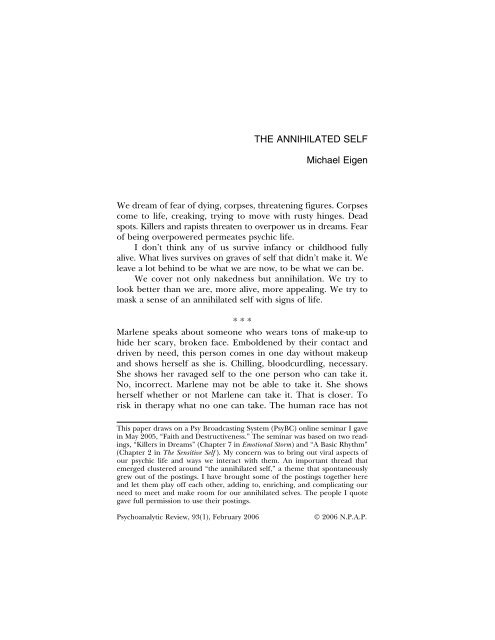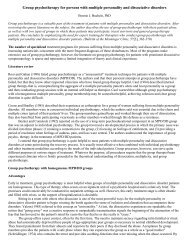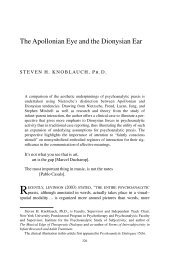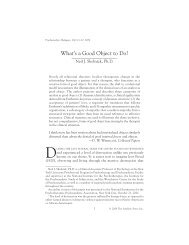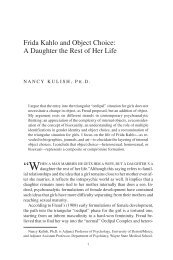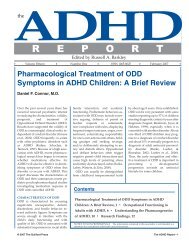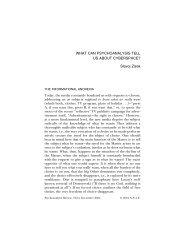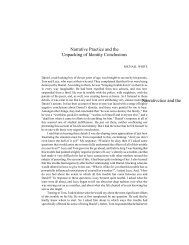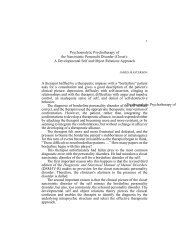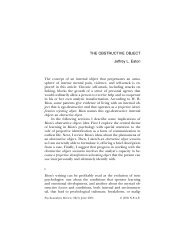THE ANNIHILATED SELF Michael Eigen - PsyBC
THE ANNIHILATED SELF Michael Eigen - PsyBC
THE ANNIHILATED SELF Michael Eigen - PsyBC
You also want an ePaper? Increase the reach of your titles
YUMPU automatically turns print PDFs into web optimized ePapers that Google loves.
<strong>THE</strong> <strong>ANNIHILATED</strong> <strong>SELF</strong><br />
<strong>Michael</strong> <strong>Eigen</strong><br />
We dream of fear of dying, corpses, threatening figures. Corpses<br />
come to life, creaking, trying to move with rusty hinges. Dead<br />
spots. Killers and rapists threaten to overpower us in dreams. Fear<br />
of being overpowered permeates psychic life.<br />
I don’t think any of us survive infancy or childhood fully<br />
alive. What lives survives on graves of self that didn’t make it. We<br />
leave a lot behind to be what we are now, to be what we can be.<br />
We cover not only nakedness but annihilation. We try to<br />
look better than we are, more alive, more appealing. We try to<br />
mask a sense of an annihilated self with signs of life.<br />
* * *<br />
Marlene speaks about someone who wears tons of make-up to<br />
hide her scary, broken face. Emboldened by their contact and<br />
driven by need, this person comes in one day without makeup<br />
and shows herself as she is. Chilling, bloodcurdling, necessary.<br />
She shows her ravaged self to the one person who can take it.<br />
No, incorrect. Marlene may not be able to take it. She shows<br />
herself whether or not Marlene can take it. That is closer. To<br />
risk in therapy what no one can take. The human race has not<br />
This paper draws on a Psy Broadcasting System (<strong>PsyBC</strong>) online seminar I gave<br />
in May 2005, “Faith and Destructiveness.” The seminar was based on two readings,<br />
“Killers in Dreams” (Chapter 7 in Emotional Storm) and “A Basic Rhythm”<br />
(Chapter 2 in The Sensitive Self ). My concern was to bring out viral aspects of<br />
our psychic life and ways we interact with them. An important thread that<br />
emerged clustered around “the annihilated self,” a theme that spontaneously<br />
grew out of the postings. I have brought some of the postings together here<br />
and let them play off each other, adding to, enriching, and complicating our<br />
need to meet and make room for our annihilated selves. The people I quote<br />
gave full permission to use their postings.<br />
Psychoanalytic Review, 93(1), February 2006 © 2006 N.P.A.P.
26 MICHAEL EIGEN<br />
evolved the capacity to take what it does to itself, the pain people<br />
inflict on each other. In therapy one risks what is too much for<br />
another, too much for oneself. One risks what no one can take<br />
or may ever be able to take. That enters the room and is shared,<br />
whether or not anyone can take it.<br />
* * *<br />
A sharing of what can’t be taken, the full scope of her patient’s<br />
annihilation. Marlene feels it in cringing at the sight of her patient’s<br />
unveiled face, a ghastly horror myths sometimes portray.<br />
Unbearable—how could this happen to a human being? She<br />
passes it to us. We join the community of those who speak about<br />
such things and express them in art. The most usual form of<br />
expression is transmission of trauma, passing trauma on to<br />
someone else, the next generation, those close to one. Inflicting<br />
ghastly things on life, through politics, family, intimacy, war, economic<br />
mendacity.<br />
Therapy takes time to sense and see what we do to each<br />
other. It dwells with impacts, sharing innermost ravage. A coming<br />
out, a showing. Even if the annihilated face pierces Marlene,<br />
stops her cold, it has been registered, noted. That Marlene is<br />
done in by what cannot be sustained enables the patient to make<br />
her mark, her impact. A glimpse of the worst puts the other out<br />
of play, but the other continues, therapy continues. In the context<br />
of therapy, derailment is a kind of sharing, a sharing of being<br />
put out of play.<br />
* * *<br />
In the case that Marlene is impelled to share, a glimpse of the<br />
whole is compressed in a face. A face that is usually covered,<br />
hidden. It is shameful to look like the annihilated being one is. It<br />
would turn others off, make one even more alone. Yet Marlene’s<br />
patient is driven to do just this. It is something therapy invites,<br />
even propels. Again, it is not a matter of surviving what can’t be<br />
survived but sharing annihilation. Being annihilated together.<br />
Her patient’s inmost devastation breaks into another human being,<br />
more thoroughly than a thief breaking into a dream.<br />
* * *
<strong>THE</strong> <strong>ANNIHILATED</strong> <strong>SELF</strong> 27<br />
An aside on Oedipus piercing his eyes, blinding himself.<br />
There are references in myth, religion, literature of dying, turning<br />
to stone, salt, some paralyzing consequence, by seeing what<br />
can’t be seen or shouldn’t be seen. That you can’t see God and<br />
live or see Medusa’s face directly and live are among images that<br />
express the sense of being done in by too much, by not being<br />
up to experience, the intensity of impact. Likewise, Oedipus.<br />
It is not simply that he blinded himself out of guilt or shame<br />
(a pars pro toto parallel of Jocasta’s suicide), but that seeing is<br />
blinding. Staring directly into the soul, like staring directly at the<br />
sun, can be too much for the organ of sight, or the capacity for<br />
experiencing. A theme of psychoanalysis: We cannot take, do<br />
not take well, do not know what to do with the ways psyche<br />
works. Yet we are drawn to see what blinds us.<br />
One of the Bible stories touching this is Aaron’s sons burnt<br />
to a crisp trying to get too close to God in their own way. They<br />
made “strange” sacrifice. Strange or weird can mean singular, individual,<br />
own. My own last name, <strong>Eigen</strong>, unites such nuances in its<br />
history, meaning strange, weird, individual, common, proper, own.<br />
Aaron’s sons did not follow the prescribed laws of sacrifice.<br />
They invented their own ritual, followed their own prompting.<br />
Rabbinic commentary says they tried to get to God directly, like<br />
the tower of Babel, an assault on divinity, an attempt at appropriation.<br />
Mystical Judaism says they burned with desire to be<br />
close to God, consuming desire. Consumed by desire, a fire that<br />
leaves nothing but God, openness, sunyata.<br />
That coming to grips with ourselves is damaging is an old<br />
theme. An equally old theme is that not coming to grips with<br />
ourselves is damaging. We have made a notation. Damage is part<br />
of life processes and the emergence of psychic life, symbolic life,<br />
ushers in new kinds of damage. Damage to personality, self, feeling,<br />
ego, spirit—new kinds of pain we create with each other.<br />
* * *<br />
Many of us want to let psychic reality speak, let experience<br />
speak, create something together. An urge to jump in, pull<br />
threads, mess up, muck around, let develop what wants to develop.<br />
In this discussion we are headed for the annihilated self.
28 MICHAEL EIGEN<br />
Marlene’s patient’s real face as frightening, bloodcurdling takes<br />
us straight to the place we are headed.<br />
We carry around an annihilated self. It can be seen peeking<br />
out in this or that trait or expression. Marlene’s patient risks<br />
showing it in a moment of truth. At times it is seen as a center of<br />
the emotive perceptual field. I think many of us see each other’s<br />
annihilated self. Like hounds, we sniff it out. Even if we look<br />
OK, we can X-ray in, find it. We begin to train ourselves to stick<br />
with what is strangulated, gone. There is no one way to talk<br />
about this. Words like “the” or “a”—the annihilated self—seem to<br />
reify, freeze a process. But they call attention to something that<br />
needs attending.<br />
I can envision a time when each other’s annihilated self will<br />
be known, felt, accepted. I don’t mean known as scientifically<br />
known, all parts laid out. We may or may not know all the details<br />
about our annihilated selves. But we know such things exist, even<br />
if we don’t know what to say of them. Annihilation processes are<br />
part of the way we are constituted. We live with dead areas. My<br />
hope is that making room for our annihilated self will enable us<br />
to be less destructive. We often injure, even destroy each other,<br />
in order to reach the realness of our annihilated beings. How<br />
much destructiveness aims at “showing” how destroyed we feel!<br />
Therapy is one place to try to contact the annihilated self without<br />
destroying ourselves. Speaking, sensing, and imagining is a<br />
less costly method of discovery than giving in to the compulsion<br />
to destroy.<br />
* * *<br />
Ellen speaks about the annihilated self in eating disorders and<br />
refers to a catastrophe at the beginning of personality formation.<br />
A patient dreamt she had been chopped into multiple parts by<br />
her mother and was in a bathtub full of blood. Ellen thought of<br />
a Sopranos episode too frightening for her to watch. Her patient<br />
depicted a psychic reality too awful to take in, yet therapy drew<br />
it out in a dream.<br />
Ellen (Pearlman, 2005) has worked with eating disorders for<br />
many years and knows the territory. She says, “My feeling is that<br />
most eating disorder patients are grossed out by their bodies top<br />
to bottom and that they often have bottom and top confused;
<strong>THE</strong> <strong>ANNIHILATED</strong> <strong>SELF</strong> 29<br />
orifices are interchangeable. They chop their bodies up and will<br />
find one part that is acceptable. I had one patient who loved her<br />
feet, but couldn’t see any of the rest of her body. I have one<br />
patient who has a tummy/mind confusion. When she eats and<br />
feels the food stay too long, she fears she will go crazy, a reversal<br />
of when she was left too long in the crib without food or attention.<br />
Neither psychic digestion nor body digestion can be trusted.”<br />
These individuals create a sense of devastation in their bodies,<br />
expressing with part of themselves a more total sense of annihilation.<br />
The ravaged, traumatized, annihilated self or self aspects<br />
find expression by channeling a circumscribed function.<br />
Although “food disorders” may present themselves as limited<br />
(pars pro toto), they can lead to death, duped by their own unconscious<br />
logic.<br />
* * *<br />
Another day Ellen tells of dread she felt upon seeing a bald<br />
woman in her exercise class, with one breast clearly delineated<br />
in her T-shirt. “Even having been through the same experience,<br />
I found it hard to know how to respond. I admired her bravery,<br />
but also knew it could be overcompensation. I have never gone<br />
in public, outside my family, without my prosthesis. I wanted to<br />
wish her well, tell her I’d been there, but didn’t want to be reminded<br />
of it either. Finally, I did just see her, didn’t avert my<br />
eyes, wasn’t embarrassed for her. Before my cancer experience<br />
I probably wouldn’t have felt that way. I wouldn’t have been able<br />
to do that. That’s something. . . .”<br />
The chill Marlene felt when her patient unmasked her horrific<br />
face brought Marlene back to her mastectomy, the loss, rupture,<br />
disfigurement. Profound dread runs through her body.<br />
Her patient’s face is her body. Her dismembered body radiates<br />
further back to childhood dreams of corpses, dying bodies,<br />
ghastly terrors, numb terrors, blank terrors. Dream terrors disfigure<br />
our beings, portray the way disfigurement feels.<br />
Ellen and Marlene share backlogs of childhood terror and<br />
trauma of adult disease. Pain makes us hide. So much shame is<br />
attached to pain. We think pain is only private and withdraw. So<br />
much childhood pain goes unanswered or misunderstood. People<br />
are afraid of each other’s pain and their own, helpless, not
30 MICHAEL EIGEN<br />
knowing how to respond to the pain of life. Yet pain resonates,<br />
links. To some extent, we grow into it and it becomes part of<br />
our sense of community, part of reaching out. Ellen and Marlene<br />
share coming through, fear of not coming through, pressure<br />
to transform. We would rather not have to grow this way.<br />
But in their case, struggle opens pathways.<br />
* * *<br />
Marlene speaks of a childhood dream. “The background of the<br />
dream was an absolute, devastating, horrific silence. On a beach<br />
lay dozens of corpses, their motionlessness melded into the silence<br />
and steeped it with death. Or perhaps I should say that<br />
death showed itself in the terrifying amalgam of silence, dead<br />
bodies, and motionlessness. The sensations of the dream I can<br />
still feel today when I remember it, although I have not remembered<br />
it in years, until this seminar. I felt I never quite understood<br />
it. It did not seem to fit in with traditional interpretations.<br />
Now I see that this dream was my annihilated self. The self my<br />
patient was threatening to re-evoke in me and from which I so<br />
wanted to run. It was the self that I faced with breast cancer and<br />
mastectomy. I believe I can go into my sessions with a bit more<br />
understanding, in a felt way, with having in dream and in words<br />
what I am so afraid of facing in her ghastly, bloodcurdling annihilated<br />
self.”<br />
Ellen and Marlene were able to see the unseeable, stay with<br />
the unstayable. A little more. Their work, their persons, better<br />
for it.<br />
Part of this seeing and staying involves letting death be.<br />
Marlene’s corpses, annihilated self, threat of actual as well as psychic<br />
death and deformation, her patient’s devastated face, devastated<br />
soul: One does not breathe life into death nor undertake<br />
reparative or hysterical activity to make life happen. One dies in<br />
some ways. Marlene stays with it, tastes it, awakened to the fact<br />
that she can let deadness be. Then the next thing happens, a<br />
process emerges, continues. We embolden each other to stay<br />
with what needs to be noticed. Our interactions play a role in<br />
letting this happen, for example, Marlene’s patient’s need to<br />
show the truth of her horror. We need to show what is too horri-
<strong>THE</strong> <strong>ANNIHILATED</strong> <strong>SELF</strong> 31<br />
ble to be seen. Even if we see it, we would not know what to do<br />
with it.<br />
A patient told me no one in her family knew what to do<br />
with a baby. She kept herself in life by relating to God. She developed<br />
an intense connection to God and masturbated a lot.<br />
When she got older she lived out some eros with men, never<br />
enough. A whole middle section of her life was never born sufficiently<br />
or died. She saw the middle area in dreams of corpses,<br />
and felt dead spots, blank spots in her body. She spoke with<br />
spiritual and erotic intensity but something in between was missing.<br />
The two extremes filled a hiatus, pouring spirit and eros<br />
into a vacuum.<br />
A lot of effort is spent trying not to look dead or trying<br />
not to see the deadness. Many deflect it into wars or disastrous<br />
triumphs of one or another sort, in which corpses litter the psychic<br />
landscape and the outside world (no neat division here). We<br />
create disasters as an attempt to make our sense of being damaged<br />
seen. Our damaged selves damage the world as a form of<br />
self-expression. Some years ago, a tour guide in the Florida Everglades<br />
spoke of the dying of the waters. One wonders what it<br />
takes to be seen.<br />
I vividly feel something of what Ellen expresses, seeing<br />
breast/no-breast baldness, bald lack showing itself like Marlene’s<br />
patient’s devastated face. Recoil, implicit horror, revulsion, or<br />
whatever fits the feeling, perhaps a kind of horrific awe. There<br />
are moments when a baby sees the Medusa-mother’s face. Or a<br />
devil face, a fiend. I am not sure a baby sees death. If a baby sees<br />
death it is an animated death, all the more frightening in being<br />
alive. Seeing death’s face, then, a certain kind of death. Shock,<br />
tightening, freezing, screaming and, if not comforted, dying out.<br />
There is already a partial dying out in the state of shock, the<br />
shock of the awful. One cannot believe even at an early age such<br />
things can happen, such things are happening to one. A shock<br />
going on all life long. Sometimes it seems worse in the teens<br />
or twenties because of the particular level of self-consciousness<br />
achieved. It is dangerous to think shock lessens within age: I am<br />
familiar with older persons dying from shock. We are never out<br />
of the woods on this score.<br />
We are only partly restored when we are restored. We know
32 MICHAEL EIGEN<br />
this because sometimes we feel more fully restored or reach a<br />
new dimension of living, and feel the difference. Ellen and Marlene<br />
struggled profoundly to meet the tragic and come through,<br />
to the point where things fell into place, reality became reality<br />
once more, just so, as it is, more fully so, more textured, the<br />
richly scarred self opening portals. Marlene (Goldsmith, 2004)<br />
speaks of her paper on Frida Kahlo’s journey into body pain,<br />
soul agony, art. She endures being twisted beyond recognition<br />
yet ends by saying “Vive la vida.”<br />
* * *<br />
Jeff’s childhood dream: “I’m at the beach looking out at the<br />
ocean. A boat approaches. I know that when the boat reaches<br />
the shore, if I get on it, I will die. It is a death boat coming to<br />
ferry me to some place called Death. I woke up screaming. My<br />
parents tell me all I talked about was “the boat-man” for the next<br />
several weeks. They didn’t know what I was talking about. I<br />
didn’t know, consciously, what I was talking about. I grew up on<br />
Puget Sound. But I wasn’t talking about boats. I was trying to<br />
talk about death, or, the preconception of death. Why? As an<br />
adult I think it was because my father’s father died just a few<br />
weeks before I was born. I know my father wanted his father to<br />
see me. My father’s mother died a year after I was born. I’m<br />
named after my mother’s father who died when she was twelve.<br />
My mother worried that I would die as a baby, once rushed me<br />
to the hospital to have my stomach pumped because she didn’t<br />
know whether or not I’d eaten dirt in the yard that had slug<br />
poison in it. My sister almost died as a fetus and her teens were<br />
filled with black and poison fragments of self and object fusing,<br />
intruding and gnawing and exploding. Something must happen<br />
in the baby’s mind and body to process “the family atmosphere,”<br />
and death was part of the mix in mine and so that became part<br />
of the depression, psychosomatic direction, and need to use<br />
imagination to find ways of moving through agonies. Intensity<br />
was the most frightening. But somehow one grows.”<br />
Jeff carves out a history for the fear of death, for the particular<br />
forms death takes in his life. But there is no history for death<br />
itself. Death or consciousness of death propels history. Death<br />
provides a history of depression. Death and fear of death seep
<strong>THE</strong> <strong>ANNIHILATED</strong> <strong>SELF</strong> 33<br />
through Jeff’s family. In the dream, death is compressed. The<br />
death boat, the boatman: Death so often depicted as movement,<br />
passage. A movement that stills movement.<br />
The boatman of the River Styx, Rimbaud’s drunken boat,<br />
meeting Death in the Upanishads . . . blends of trauma and<br />
beauty, annihilation and creativity. Children have a drive to<br />
know death as well as sex. A drive toward the real, to experience<br />
with all their might, a drive that is frightened out of them, depressed<br />
out of them. The boatman scares the life out of them.<br />
Areas of deadness, emptiness ensue. One becomes frightened of<br />
life. The dream teaches that children get more than they bargained<br />
for. They get the knowledge they were after and that petrifies<br />
them.<br />
It is not just the turning back but the seeing of destruction,<br />
the destructive truth, that turns Lot’s wife to salt. And Orpheus?<br />
Is it merely because he turns to see Eurydice that he loses her,<br />
or because seeing is too much, the hell that touches her too<br />
much to bear?<br />
Yet there is need for intensity, immersion, resistance, impact,<br />
as well as need to hide and make believe things are better<br />
and need to go on. A drive to know what one is afraid to know,<br />
taste what one is afraid to taste. The boat as death-driven body,<br />
a body one feels is life. For Rimbaud, the boat adrift in life is<br />
poetic impulse, psychic movement. Some fear psychic movement<br />
as death. The body lets one down, life lets one down. To<br />
go on, drive through everything that slows one up, to move forward<br />
with gunshot in one’s gut, a hole in one’s heart. One gains<br />
a sense of satisfaction moving with such impediments, sometimes<br />
racing, flying. No wonder we can’t get out of bed. We appreciate<br />
the Zen master who lifts a finger: If you can lift a finger,<br />
you can do anything. To lift oneself up, get a lift, lighten spirit.<br />
We must be quite a weight to ourselves.<br />
Jeff’s aesthetic and truth sense is part of innate reality. Over<br />
a lifetime it gains intensity, fills out by tasting death. Jeff says<br />
death shut him down, provoked fear of intensity. He has written<br />
about deep mind-destructive processes (Eaton, 2005). What puts<br />
one out of play when one is younger feeds one’s unfolding as<br />
one grows. One contracts with threats for many years. Chilled<br />
with terror, fearful of unending contraction. But as a grown-up,
34 MICHAEL EIGEN<br />
life grows larger, taking death in. One grows into death. Death<br />
warms life as one grows into it, adds tone to beauty, although<br />
this doesn’t stop us from screaming. “I woke up screaming.” As<br />
a child, as an adult. A scream we never grow into completely.<br />
* * *<br />
Mac: “One day many years ago I was watching the morning news<br />
and saw JonBenet Ramsey for the first time. Performing. As accompaniment<br />
to the news of her murder. (I knew nothing of<br />
child beauty pageants.) I found myself dissolved in tears. ‘How<br />
could anyone do that to a child?’ I asked myself—sexualize a<br />
child in that way and parade that to a pedophilic culture. The<br />
image of that child entered my psyche the way a traumatic image<br />
must. All defenses were stripped away. The psyche was reduced<br />
to sufferance. A suffering that wouldn’t stop, uncontainable suffering.<br />
For me the only possible response was to try to constitute<br />
her trauma, to let her speak. Three years later I had a play with<br />
her as the main character: only one who doesn’t die at 6 but<br />
who we meet at 35 in a series of monologues interspersed with<br />
flashbacks (Davis, 2003). The brunt of it all was not to resolve<br />
her trauma but to constitute it. To try to get inside a psyche that<br />
was so deeply violated that consciousness itself became the agony<br />
of the why, to open to the traumatic wound at the core of the<br />
psyche and living from there.”<br />
Mac speaks of tragic creativity growing from this pain, this<br />
agony at the heart of psychic trauma. Art, words growing from<br />
violation, annihilation. One constitutes oneself within this annihilated<br />
core.<br />
He shares a dream from his own childhood: “Still a child,<br />
dressed in the little blue Navy suit modeled on the one my father<br />
wore, I lie in a casket in a dim room lighted only by candles. All<br />
the family is there, hushed, seated in a circle, like mannequins<br />
frozen in formal poses and ritual gestures. I am calm (perhaps<br />
for the first time.) All struggle is gone, all protest. I accept what<br />
has happened in a spirit of love. Only one thing remains. A request.<br />
Without moving I ask them to make an exception to a<br />
rule that I already know cannot be broken. But it is the thing I<br />
need more than anything. And so I ask them again to bring<br />
Brownie, the teddy bear I love, and place him next to me so I
<strong>THE</strong> <strong>ANNIHILATED</strong> <strong>SELF</strong> 35<br />
won’t be alone. It is a plea but there is no panic in it, yet no<br />
hope that it will be heeded. And so finally in the great rush of<br />
what must be love I accept it all. It is what they’ve been waiting<br />
for, the thing that enables them to cry. The cry grows. It is the<br />
bond that unites them, giving them the identity they need to be<br />
a family. This knowledge is the central reality that frees me to<br />
what I now know I must do. I’m alone then, down in a crypt, in<br />
a cold stone place, a realm of shadow in a dim twilight. I go<br />
forward, toward a casket. I see myself lying there, in it—and I<br />
become what I see. A child is sleeping, beautiful and resigned.<br />
The beginnings of a smile are frozen on his lips. But no one will<br />
come to kiss them back to life. He will stay like this forever. He<br />
is sleeping but he will not awaken.”<br />
Among Mac’s remarks: “My hunch is that if we get to the<br />
annihilated self we will find a dead child. That dead child is, of<br />
course, oneself.”<br />
One reason I write is so I do not entirely remain a resigned<br />
sleeping beauty at whom I stare while the Greek chorus of my<br />
stiffened soul weeps. You can see why love can be mistrusted. It<br />
keeps one quiet. It creates a bond of death. Beautiful resignation.<br />
Look what one has to do to bring the family together: One<br />
has to die to keep the family together, a death that is part of<br />
socialization. A toxic bond, a damaged bond acting as personal<br />
and social cement. The dream expresses a dying out or mock<br />
death that goads Mac to speak. Keep the family together, no<br />
matter how impossible. Keep the self together, no matter how<br />
impossible. We are speaking of existential nuclei, inner dead babies,<br />
or almost-dead babies, or pretend death. This is a precious<br />
transmission.<br />
Love as an awful force to keep one down. Mac is telling us<br />
he refuses to be quiet. He will not go through his whole life<br />
watching the death of himself, a ghost of himself, a sleeping<br />
beauty akin to the mysterious resignation of Peter Pan’s mother<br />
(in Barrie’s prose).<br />
In Toxic Nourishment (<strong>Eigen</strong>, 1999, pp. 150–154) I described<br />
a man falling into passive inertia, yet listening, listening. For the<br />
sound of his parents in the dark? For signs of his dying process?<br />
We listen for signs of life and for signs of un-life. Mac objects to<br />
“normality” not only as masking psychosis but as a form of mad-
36 MICHAEL EIGEN<br />
ness. One is stuffed with deforming socialization processes that<br />
one takes a stand over and against as one goes under.<br />
We see in this seminar waves of the annihilated self, hints<br />
of processes. Many people communicate the reality of some kind<br />
of dying or devastation. A seemingly cellular infiltration of the<br />
self by psychic death is meaningful. There is hunger to share it.<br />
Psychic death, even more than physical death, is complex.<br />
Psychic death is woven with many threads of life and simulacra<br />
of life. Death feeds death with sparks of life. Even pretend life is<br />
not without the nerves of life. Where there is exploitation and<br />
subterfuge someone pays with some sort of life loss. The powerful<br />
self and the annihilated self are aspects of life, aspects of our<br />
lives.<br />
It was moving that people shared the sense of devastation<br />
related to body, to face, to children, to family. One might say<br />
Annihilation with a Thousand Faces, but it is more than a thousand.<br />
We are not celebrating trauma but constituting it, attesting<br />
to its reality. Why? Many reasons, one being that trauma and<br />
its effects get brainwashed, twisted, whitewashed, blackwashed<br />
away.<br />
We can see on the political scene how adults con children,<br />
infiltrate minds, twist reality. We were fed lies to go to war in<br />
Iraq (note an implicit infant-breast reference), fed catastrophic<br />
threats (they have weapons of mass destruction). Catastrophic<br />
anxiety is manipulated in the service of power and control, exploited<br />
as part of “socialization” processes. We fuzz out our<br />
sense of taking in lies, anesthetize disbelief as we give in. Leaders<br />
play on fear of destruction to get people to destroy, play on<br />
trauma to channel the will to traumatize, manipulate ideals to<br />
get people to do what they want. Leaders pretend to know what<br />
they are doing and we dull our awareness that they are quasidelusional.<br />
We join in our leaders’ hallucinations (and in hallucinating<br />
leaders) in our need to channel psychotic dreads by exercising<br />
power.<br />
What I feel happening in communication attempts in the<br />
online seminar is making room for the annihilated self and annihilating<br />
processes, in the hope that we will not have to damage<br />
each other too badly. We are trying to share what we are up<br />
against, touch it, taste it. Sensitivity to this “ouch” is important.
<strong>THE</strong> <strong>ANNIHILATED</strong> <strong>SELF</strong> 37<br />
Often it tells us something bad is happening. Not only bad but<br />
wrong, evil. A sensitivity implicitly allied with a sense of justice,<br />
a justice that cares for human beings. Mac’s shattering pain that<br />
he will never recover from upon seeing JonBenet’s disfigurement<br />
on the altar of familial and social narcissism bears witness<br />
to a link between the impact of trauma on sensitivity and the<br />
growth of ethics. Too often, instead of authentic ethical concern,<br />
waves of derangement fill the space where sensitivity to trauma<br />
ought to be. An ethical imperative worth thinking about, akin to<br />
the golden rule, based on sensitivity to trauma, an ethical impulse<br />
we bury in shame, fear, powerlessness, and the will to<br />
power. Our job is to help sensitivity to evolve, which includes<br />
recovering and developing the ethical impulse nested in it.<br />
* * *<br />
Is there a particular way to approach the annihilated self? In<br />
talks one is often asked, “How do you do it? What should I do?”<br />
There is no one way. Here is a short recounting of a father linking<br />
with a son’s sense of death. In this case, death was a concrete<br />
childhood threat, not exactly the annihilated self we are speaking<br />
of (self crushed through trauma and growth). However, the<br />
method of approach is related to what we are trying to connect<br />
with.<br />
Kerry (for more from this speaker, see Gordon, 2004):<br />
“When my youngest son was three months old, he developed a<br />
rare disease that should have killed him (by all odds) and almost<br />
did kill him. He spent three years on chemotherapy, and twice<br />
more was at the threshold of death. There are, of course, family<br />
stories about this, but he has been vigorously healthy now for<br />
many years and this experience is not often (overtly) in the foreground<br />
any more. From about five years of age on, sometimes<br />
with external cues and sometimes not, he would suddenly collapse<br />
into a place of abject horror and say to me, ‘Daddy, I don’t<br />
want to die.’ (At fourteen, this is now about the only time he<br />
says ‘Daddy’). I very quickly learned that ‘comforting’ him was<br />
not only useless, but in fact made it worse. For years now, when<br />
this happens I find myself collapsing with him, feeling a kind of<br />
. . . something . . . which I will not even try to name. I nod and<br />
we will make some kind of light physical contact and within a
38 MICHAEL EIGEN<br />
few seemingly endless moments it will pass for both of us. Over<br />
the last couple of years the statement has changed to ‘Daddy,<br />
I’m going to die,’ offered matter-of-factly in tone, but with a look<br />
that is, once again, something I can’t describe. It feels so true to<br />
me that this felt awareness of the horizon line of life/death (I<br />
have a fantasy that he feels death at a cellular level) is one of the<br />
(many) wavelengths of experience which combine to create his<br />
being.”<br />
“I can’t say that what I provide him in these moments is<br />
so much containment as it is company, or maybe containment<br />
through company. Which brings me to a question asked earlier:<br />
why we sometimes devastate others, maybe most particularly<br />
those we love the most. I have a strong sense that we often do it<br />
because our most broken, most annihilated selves crave companionship,<br />
and we really don’t know what else to do.”<br />
This collapse into being with another, the deepest states of<br />
the other—isn’t this something of the kind of sensitivity that<br />
gives our annihilated states a home?<br />
REFERENCES<br />
Davis, W. A. (2003). An evening with JonBenet Ramsey: A play and two essays.<br />
Xlibris Corporation.<br />
Eaton, J. L. (2005). The obstructive object. Psychoanal. Rev., 92:355–372.<br />
<strong>Eigen</strong>, M. (1999). Toxic nourishment. London: Karnac Books.<br />
Goldsmith, M. (2004). Frida Kahlo: Abjection, psychic deadness, and the creative<br />
impulse. Psychoanal. Rev., 91:723–758.<br />
Gordon, K. (2004). The tiger’s stripe: Some thoughts on psychoanalysis, gnosis,<br />
and the experience of wonderment. Contemp. Psychoanal., 40:5–45.<br />
Pearlman, E. (2005). Terror of desire: The etiology of eating disorders from<br />
an attachment theory perspective. Psychoanal. Rev., 92:223–336.<br />
225 Central Park West, #101A<br />
New York, NY 10024<br />
E-mail: mikeigen@aol.com<br />
The Psychoanalytic Review<br />
Vol. 93, No. 1, February 2006


